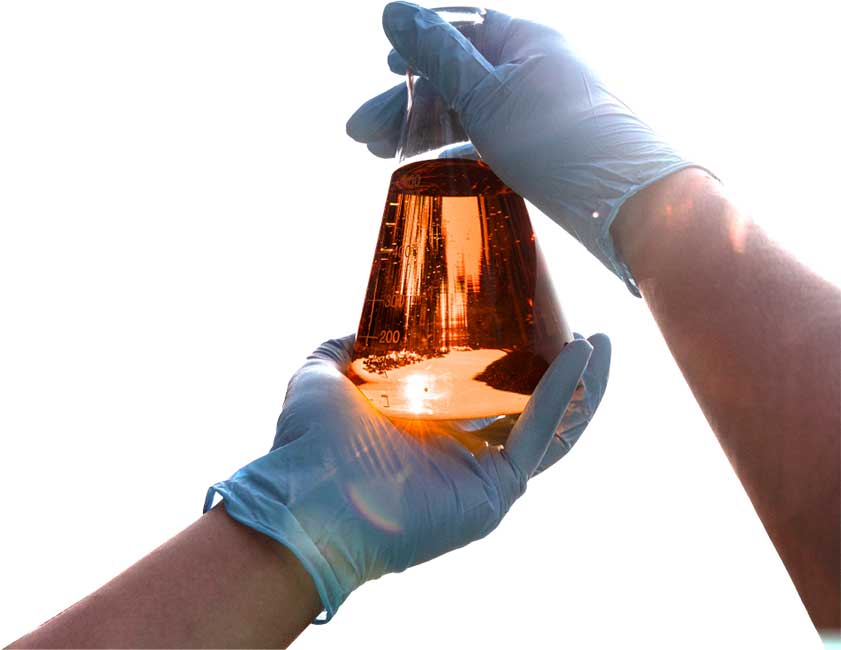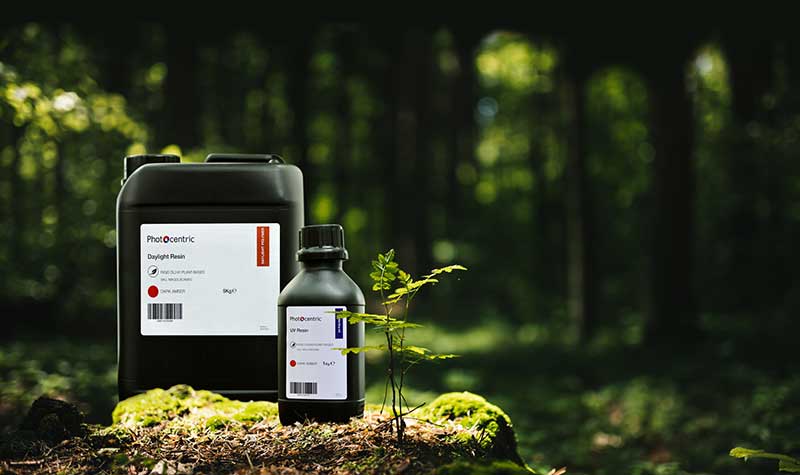Why the properties of plant-based 3D printing resins are now exceeding oil derived
Why the properties of plant-based 3D printing resins are now exceeding oil derived

There has been an increasing demand for 3D resins made from sustainable sources. Traditionally, oil-derived resins have supplied the vast majority of 3D printing resins, but a new generation of bio-based resins are now offering impressive properties. Previously there had always been a compromise on performance if a user wanted to go green. Photocentric looked at numerous bio-based raw materials, both from plants and bio-waste streams. Dr Rob Young, Head of Chemistry at Photocentric, commented ‘the question we were answering was why couldn’t you get better properties that exceeded those from oil (effectively just a soup of animals and plants brewed over a few million years) if you selected a specific polyol from a plant with exceptional properties’.
Reducing carbon footprint in
3D Printing
Bio-derived resins provide the advantage that they benefit the environment, but they can now also enhance the overall 3D printing experience. SLA offers an attractively low carbon footprint, and exposure via an LCD screen is the least energy intensive method of the three main resin printing techniques. Prototyping doesn’t create a lot of product and therefore the CO2 generated hasn’t been a great concern, but now as 3D printing moves towards mass manufacturing the need to calculate and reduce the total carbon content in the plastic chain has become more pressing.
“We discovered that camphene, a natural compound found in trees and fast-growing plants, possesses remarkable properties that can enhance resin performance.”
Dr. Rob Young
Head of Chemistry at Photocentric
Harnessing the power of nature for resin development
Photocentric has looked at a number of single plant sources, and found some surprising advantages over oil-derived ones. Dr Rob Young commented ‘We have used monomers made from tree waste, camphene. It’s the most widely encountered terpenoid in nature, appearing in conifers and other trees as well as in fast growing plants such as cannabis and cypress. It can also before formed from alpha-pinene, further increasing its feedstock capability. Their chemical structure lends themselves to relatively trivial chemical processes to form monomers that have amazing diluting powers with high bio-content.’

Plant-Based Resins: Strong and Versatile
Photocentric have launched a polymer with an oligomer made from plant oil. The plant includes a mixture of triglycerides and is already used as a bio-based polyol in the polyurethane industry as a rigid polyol in UV coatings and epoxidized in epoxy coatings. This structure is tough enough to be used in concrete and as a construction aggregate, so it’s certainly tough enough to make 3D printed plastic parts.
Photocentric’s recently launched grade Rigid DL240 Pant-Based resin, is majority composed of an oligomer made from corn waste polyol and provides impressive properties, high accuracy, high tensile strength and low water absorption. Plants have evolved over generations to hold as much water as possible in a variety of conditions, making them an ideal source of material that inhibits water uptake.
Part of the journey to being sustainable is to calculate the carbon embedded in the process, Photocentric are now testing to ASTM D6866-21 for carbon14 radioactivity and will be providing these numbers as standard disclosures on their technical data sheets. In addition, in conjunction with The Manufacturing Technology Centre (MTC) in Coventry they are creating a compete carbon fingerprint for every 3D part they make, going back to the creation of the raw materials and counting the energy used and wasted used in the 3D printing process.
The journey to reducing the carbon footprint associated with 3D printing is now well underway. Bio-based resins are now established and gaining a growing market share. They offer many advantages in their sustainability, reduced environmental impact, and localised production while no longer relying on external countries’ oil reserves, but they are now finally giving users enhanced properties.
Plant-Based Resins: Strong and Versatile
Photocentric have launched a polymer with an oligomer made from plant oil. The plant includes a mixture of triglycerides and is already used as a bio-based polyol in the polyurethane industry as a rigid polyol in UV coatings and epoxidized in epoxy coatings. This structure is tough enough to be used in concrete and as a construction aggregate, so it’s certainly tough enough to make 3D printed plastic parts.
Photocentric’s recently launched grade Rigid DL240 Pant-Based resin, is majority composed of an oligomer made from corn waste polyol and provides impressive properties, high accuracy, high tensile strength and low water absorption. Plants have evolved over generations to hold as much water as possible in a variety of conditions, making them an ideal source of material that inhibits water uptake.
Part of the journey to being sustainable is to calculate the carbon embedded in the process, Photocentric are now testing to ASTM D6866-21 for carbon14 radioactivity and will be providing these numbers as standard disclosures on their technical data sheets. In addition, in conjunction with The Manufacturing Technology Centre (MTC) in Coventry they are creating a compete carbon fingerprint for every 3D part they make, going back to the creation of the raw materials and counting the energy used and wasted used in the 3D printing process.
The journey to reducing the carbon footprint associated with 3D printing is now well underway. Bio-based resins are now established and gaining a growing market share. They offer many advantages in their sustainability, reduced environmental impact, and localised production while no longer relying on external countries’ oil reserves, but they are now finally giving users enhanced properties.
